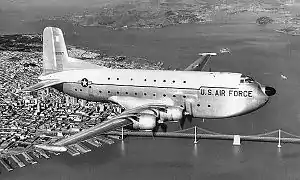19th Military Airlift Squadron
 | |
|---|---|
 | |
| Active | 1942–1943; 1952–1969 |
| Country | |
| Branch | |
| Role | Airlift |
| Part of | 62d Military Airlift Wing (1962-69) |
| Decorations | Air Force Outstanding Unit Award[1][2] Republic of Vietnam Gallantry Cross with Palm[2] |
| Insignia | |
| 19th Logistic Support Squadron emblem (approved 26 January 1956) |  |
The 19th Military Airlift Squadron is an inactive United States Air Force unit. It was last assigned to the 62d Military Airlift Wing, Military Airlift Command, stationed at McChord Air Force Base, Washington. It was inactivated on 22 December 1969.
History
World War II

The first predecessor of the squadron was activated at Salt Lake City Army Air Base, Utah in July 1942 as the 363d Bombardment Squadron, one of the four original squadrons of the 304th Bombardment Group. In September, the squadron moved to Geiger Field, Washington, where it received its first personnel and began training with Boeing B-17 Flying Fortresses, but soon moved to Virginia and switched to the Consolidated B-24 Liberator.[3][4]
After its arrival on the eastern seaboard, the squadron began antisubmarine warfare patrols. In November, it was renamed the 19th Antisubmarine Squadron and in December, its parent 304th Bombardment Group, whose squadrons had dispersed to various locations, was inactivated and the squadron was assigned to the 25th Antisubmarine Wing, which supervised Army Air Forces throughout the Atlantic coast.[3][5] The Navy believed that more antisubmarine forces were required to protect convoys in the North Atlantic, where attacks were becoming more concentrated. In March, the 19th Antisubmarine Squadron relocated to CFB Gander in Newfoundland, soon joined by two other squadrons.[6]
US Army Air Forces Antisubmarine Command had moved some of its north American based antisubmarine squadrons to England in December 1942 as the 2037th Antisubmarine Wing (Provisional), but those early squadrons had subsequently been moved-on to airfields in French Morocco, where they were formed-up into the newly created 480th Antisubmarine Group under the control of the United States Navy Fleet Air Wing 15, part of the Moroccan Sea Frontier.
To replace them, the antisubmarine squadrons in Newfoundland, including the 19th, were moved to RAF St Eval in Cornwall in March 1943, where they formed the 479th Antisubmarine Group[7] under the control of No. 19 Group of RAF Coastal Command. The group conducted patrols over the Bay of Biscay in coordination with the RAF Coastal Command, achieving its greatest success in the first two months it was in action. Following this period, German U-boats adopted tactics that kept them submerged in the group's area of operations during daylight hours. The 479th Group continued its patrols, occasionally engaging Luftwaffe aircraft until October. The 479th Group was disbanded in England in November, along with the 19th Squadron.[3][8]
Special Weapons transportation
The second predecessor of the unit was established as the 19th Logistic Support Squadron in 1952 as the first of three logistic support squadrons organized by Air Materiel Command.[note 1] Its mission was to provide worldwide airlift of nuclear weapons and related equipment,[9][10] with a secondary mission to airlift other Department of Defense cargo as required when space was available.
In 1963, Military Air Transport Service assumed the mission of transporting special weapons and the squadron was reassigned to the 62d Troop Carrier Wing, one of the command's two C-124 troop carrier wings. Shortly before its inactivation, its mission changed to that of strategic transport squadron flying worldwide airlift operations. It was inactivated in 1969 with the retirement of the C-124.
In 1985 the two squadrons were consolidated and redesignated as the 19th Aeromedical Airlift Squadron.[11]
Lineage
- 19th Antisubmarine Squadron
- Constituted as the 363d Bombardment Squadron (Heavy) on 28 January 1942
- Activated on 15 July 1942
- Redesignated 19th Antisubmarine Squadron (Heavy) on 29 November 1942
- Disbanded on 11 November 1943[12]
- Reconstituted on 19 September 1985 and consolidated with the 19th Military Airlift Squadron as the 19th Aeromedical Airlift Squadron[11]
- 19th Military Airlift Squadron
- Constituted as the 19th Logistic Support Squadron on 1 September 1952
- Activated on 23 September 1952[9]
- Redesignated 19th Air Transport Squadron, Special on 8 July 1964 1965
- Redesignated 19th Military Airlift Squadron, Special on 27 December 1965
- Redesignated 19th Military Airlift Squadron on 8 April 1969
- Inactivated on 22 December 1969
- Consolidated with the 19th Antisubmarine Squadron as the 19th Aeromedical Airlift Squadron on 19 September 1985[11]
Assignments
- 304th Bombardment Group, 15 July 1942
- 25th Antisubmarine Wing, 30 December 1942
- Army Air Forces Antisubmarine Command, 8 June 1943
- 479th Antisubmarine Group, 8 July – 11 November 1943[12]
- San Antonio Air Materiel Area, 23 September 1952
- 3079th Aviation Depot Wing, 6 February 1955
- 39th Logistic Support Group, 8 July 1962
- 62d Troop Carrier Wing (later 62d Air Transport Wing, 62d Military Airlift Wing), 1 July 1963 – 22 December 1969[13]
Stations
- Salt Lake City Army Air Base, Utah, 15 July 1942
- Geiger Field, Washington, 15 September 1942
- Ephrata Army Air Field, Washington, 1 October 1942
- Langley Field, Virginia, 29 October 1942 – 19 March 1943
- Gander Airport, Newfoundland, 19 March – c. 25 June 1943
- RAF St Eval (Station 129),[14] England, C. 30 June 1943
- RAF Dunkeswell (Station 173),[14] England, 6 August 1943
- RAF Podington, England (Station 109),[14] 11 November 1943[12]
- Kelly Air Force Base, Texas, 23 September 1952 – 22 December 1969[9][15]
Aircraft
- Boeing B-17 Flying Fortress, 1942
- Consolidated B-24 Liberator, 1942–1944[12]
- Douglas C-124 Globemaster II 1952–1969
References
- Notes
- ↑ The other two squadrons were the 28th Logistic Support Squadron, activated at Hill Air Force Base in 1953, and the 7th Logistic Support Squadron, activated at Robins Air Force Base in 1954. The squadrons were familiarly known as the "7th, 19th and 28th Logs" and each incorporated a log into its squadron emblem.
- Citations
- ↑ AF Pamphlet 900-2, 15 June 1971, p. 128
- 1 2 AF Pamphlet 900-2, Vol. II, 30 September 1976, p. 17
- 1 2 3 Maurer, Combat Squadrons, p. 101
- ↑ Maurer, Combat Units, p. 177
- ↑ Maure, p.
- ↑ Maurer, Combat Squadrons, pp. 25–26, 37–38, 101
- ↑ Ferguson, p. 99
- ↑ Maurer, Combat Units, pp. 350-351
- 1 2 3 "Abstract, History 19 Logistic Support Squadron Sep-Dec 1952". Air Force History Index. Retrieved 30 March 2017.
- ↑ "Abstract, History 19 Logistic Support Squadron Jan-Jun 1958". Air Force History Index. Retrieved 30 March 2017.
- 1 2 3 Department of the Air Force/MPM Letter 662q, 19 September 85, Subject: Reconstitution, Redesignation, and Consolidation of Selected Air Force Tactical Squadrons
- 1 2 3 4 1942-1943 Lineage, including assignments, stations and aircraft, in Maurer, Combat Squadrons, p. 101
- ↑ Ravenstein, pp. 98-100
- 1 2 3 Station number in Anderson.
- ↑ Mueller, p. 283
Bibliography
![]() This article incorporates public domain material from the Air Force Historical Research Agency
This article incorporates public domain material from the Air Force Historical Research Agency
- Anderson, Capt. Barry (1985). Army Air Forces Stations: A Guide to the Stations Where U.S. Army Air Forces Personnel Served in the United Kingdom During World War II (PDF). Maxwell AFB, AL: Research Division, USAF Historical Research Center. Archived from the original (PDF) on 4 March 2016. Retrieved 7 July 2012.
- Ferguson, Arthur B. (April 1945). "The AAF Antisubmarine Command, AF Historical Study No. 107" (PDF). Assistant Chief Air Staff, Intelligence. Retrieved 17 February 2016..
- Maurer, Maurer, ed. (1983) [1961]. Air Force Combat Units of World War II (PDF) (reprint ed.). Washington, DC: Office of Air Force History. ISBN 0-912799-02-1. LCCN 61060979. Retrieved 17 December 2016.
- Maurer, Maurer, ed. (1982) [1969]. Combat Squadrons of the Air Force, World War II (PDF) (reprint ed.). Washington, DC: Office of Air Force History. ISBN 0-405-12194-6. LCCN 70605402. OCLC 72556. Retrieved 17 December 2016.
- Mueller, Robert (1989). Air Force Bases, Vol. I, Active Air Force Bases Within the United States of America on 17 September 1982 (PDF). Washington, DC: Office of Air Force History. ISBN 0-912799-53-6.
- Ravenstein, Charles A. (1984). Air Force Combat Wings, Lineage & Honors Histories 1947-1977. Washington, DC: Office of Air Force History. ISBN 0-912799-12-9.
- "AF Pamphlet 900-2, Unit Decorations, Awards and Campaign Participation Credits" (PDF). Washington, DC: Department of the Air Force Index. 15 June 1971. Archived from the original (PDF) on 4 August 2015. Retrieved 11 August 2016.
- "AF Pamphlet 900-2, Unit Decorations, Awards and Campaign Participation Credits, Vol II" (PDF). Washington, DC: Department of the Air Force. 30 September 1976. Archived from the original (PDF) on 4 August 2015. Retrieved 11 August 2016.
- Further reading
- Warnock, Timothy. "The Battle Against the U-Boat in the American Theater" (PDF). Bolling AFB, DC: Air Force History Support Office. Retrieved 22 June 2015.